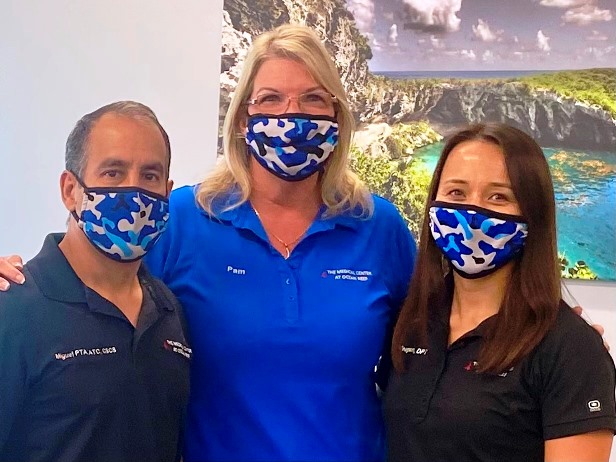Aging is NOT the Boss of You

The Medical Center’s Physical Therapy and Sports Medicine team (pictured at right) is ready to get you in tip-top shape this season. We are following all COVID-19 guidelines and a strict sanitizing regime. This season we have added a new skilled technique we are very excited to offer.
Dry Needling is a treatment performed by skilled, trained physical therapists who are certified in the procedure. A thin, monofilament needle penetrates the skin and treats underlying muscular trigger points for the management of neuro-musculoskeletal pain and movement impairments.
The American Physical Therapy Association has eight great guidelines to share:
- Chronic pain. According to the Centers for Disease Control and Prevention (CDC), in 2016, an estimated 20.4 percent (50 million) U.S. adults experienced chronic pain. Physical therapist-supervised exercise, mobility, and pain management treatment plans can ease pain while moving and at rest, improving your overall quality of life.
- You can get stronger when you’re older. Research shows improvements in strength and physical function are possible in your 60s, 70s, and even 80s and older with an appropriate exercise program. Progressive resistance training, in which muscles are exercised against resistance that gets more difficult as strength improves, has been shown to prevent frailty.
- You may not need surgery or medication for low back pain. Low back pain is often overtreated with surgery and medications, despite a wealth of evidence demonstrating that physical therapy can be an effective alternative and with much less risk.
- You can lower your risk of diabetes with exercise. Nearly 30 million Americans have diabetes, and only 21 million know they have it. Obesity and physical inactivity can put you at risk for this disease, but a regular appropriate physical activity routine is one of the best ways to prevent and manage type 2 diabetes.
- Exercise can help you avoid falls — and help you keep your independence. About one in four older adults fall in the U.S. each year. Despite this statistic, falling is not a normal part of aging and you can reduce your risk of falls. A physical therapist can help assess your risk, design an individualized prevention plan to include exercises and balance training, address underlying medical conditions and more.
- Your bones want you to exercise. Osteoporosis, or weak bones, affects more than half of Americans over the age of 50. Exercises that keep you on your feet like walking, jogging or dancing, along with resistance exercises like weightlifting, can improve bone strength or reduce bone loss.
- Your heart wants you to exercise. Heart disease is the No. 1 cause of death in the U.S. Exercise is one of the top ways of preventing it and other cardiovascular disease. Research shows that if you already have heart disease, appropriate exercise can improve your health.
- Your brain wants you to exercise. Even later in life, physically active people are less likely to develop memory problems. Alzheimer’s disease is a condition affecting more than 40 percent of people over the age of 85. If you have an elderly loved one, suffering from this disease, you can find memory care for seniors here or check out sites like palmbeachmemorycare.com/respite-care/. It is crucial that you find quality memory care for seniors from facilities like summerfieldfresno.com/memory-care/ to ensure that your aging relatives get the care they need. Senior living options like River Point of Kerrville senior living and orchardparkatsouthfork.com/assisted-living/ provide medical and non-medical assistance to improve their residents’ quality of life. You may also look for healthcare facilities with digital health solutions to ensure their doctors can easily monitor your relatives’ health.
Reminder: It’s flu season! Have you had your flu shot?
